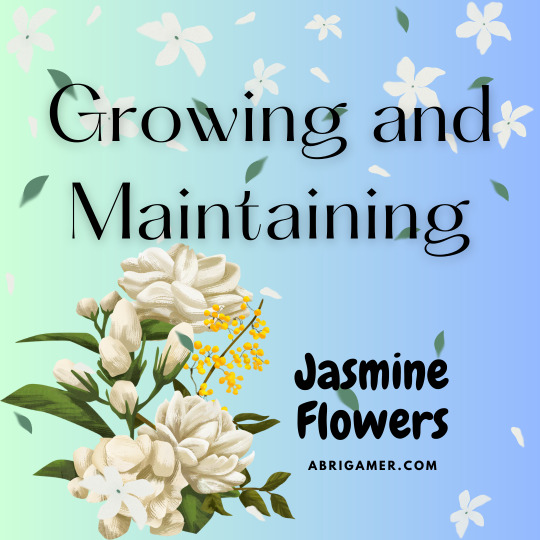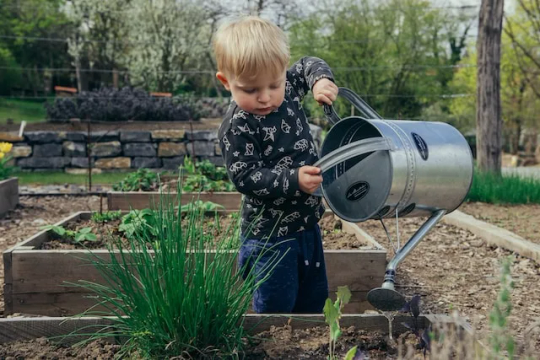#PlantingJasmine
Text
Expert Advice on Growing and Maintaining Beautiful Jasmine Flowers

Jasmine flowers are admired for their delicate beauty and sweet fragrance. They are relatively easy to grow and take care of, even for beginners. In this beginner’s guide, we will provide some basic tips on growing and caring for beautiful jasmine flowers.
Jasmine flowers are known for their sweet fragrance and delicate appearance. They are popular in gardens all over the world, and with good reason. Not only are they beautiful to look at, but they are also relatively easy to grow and maintain. In this blog post, we provide some expert advice on growing and maintaining beautiful jasmine flowers.
- Choose the Right Type of Jasmine Flower
- Planting and Soil for Jasmine Flowers
- Watering and Fertilizing for Jasmine Flowers
- Pruning for Jasmine Flowers
- Pests and Diseases for Jasmine Flowers
- Harvesting Jasmine Flowers
- Expert Advice on Growing and Maintaining Beautiful Jasmine Flowers- Choose the Right Soil
- Plant in the Right Location
- Water Regularly
- Fertilize Regularly
- Prune Regularly
- Watch for Pests and Diseases
- Conclusion

#image_title
Choose the Right Type of Jasmine Flower
There are several types of jasmine flowers, including common jasmine, night-blooming jasmine, and Arabian jasmine. Common jasmine is the easiest to grow and care for, making it a great choice for beginners. Arabian jasmine is popular for its strong fragrance, but it requires more care than other types.
Planting and Soil for Jasmine Flowers
Jasmine plants require well-draining soil with a slightly acidic pH between 6.0 and 7.5. Before planting, loosen the soil and mix in organic matter, such as compost or aged manure, to improve drainage and nutrient content. Plant your jasmine flowers in an area that receives at least six hours of direct sunlight daily.
Watering and Fertilizing for Jasmine Flowers
Water your jasmine plants regularly to keep the soil moist but not waterlogged. Potted plants should be watered more frequently than those planted in the ground. Fertilize your plants once a month during the growing season with a balanced fertilizer, but be careful not to over-fertilize, as this can cause damage to the plant.
Pruning for Jasmine Flowers
Prune your jasmine plants after flowering, immediately removing any dead or diseased branches and shaping the plant as desired. Regular pruning will help maintain the plant’s shape and encourage new growth.
Pests and Diseases for Jasmine Flowers
Jasmine plants are usually resistant to pests and diseases, but they can still be affected by spider mites, aphids, and whiteflies. Treat any infestations with insecticidal soap or neem oil, being careful not to use any products that may harm beneficial insects like bees.
Harvesting Jasmine Flowers
- Best time of day and season to harvest jasmine flowers
- Proper techniques for harvesting and drying flowers
- Creative ways to use harvested jasmine flowers, such as making tea or perfume

#image_title
Expert Advice on Growing and Maintaining Beautiful Jasmine Flowers
Choose the Right Soil
The first step in growing beautiful jasmine flowers is to choose the right soil. Jasmine plants prefer well-draining soil that is slightly acidic. If the soil is too alkaline, the plant may not thrive. You can test the acidity of your soil with a soil test kit, which can be purchased at most garden centers. If your soil is too alkaline, you can lower the pH by adding sulfur or peat moss to the soil.
- Overview of different jasmine varieties and their unique characteristics
- Factors to consider when choosing a jasmine variety, such as climate, sun exposure, and soil type
Plant in the Right Location
Jasmine plants prefer full sun, but they can also tolerate some shade. When choosing a location, make sure the plant will get at least six hours of direct sunlight each day. Additionally, jasmine plants do well in areas with good air circulation. If you live in an area with high humidity or stagnant air, you may need to plant your jasmine in an area with more airflow.
- Best time of year to plant jasmine flowers
- Soil preparation tips, including soil type and pH level
- Watering and fertilization recommendations
Water Regularly
Jasmine plants need regular watering, especially during the growing season. The soil should be kept moist, but not waterlogged. You can water your plants once or twice a week, depending on the weather conditions in your area. If you live in a particularly hot or dry climate, you may need to water your plants more frequently.
Fertilize Regularly
Jasmine plants benefit from regular fertilization. Use a balanced fertilizer that contains equal amounts of nitrogen, phosphorus, and potassium. You can fertilize your plants once a month during the growing season. Be sure to follow the instructions on the fertilizer package carefully, as over-fertilization can damage the plant.
Prune Regularly
Pruning your jasmine plants can help keep them healthy and beautiful. Prune the plants immediately after flowering to encourage new growth and prevent the plant from becoming too woody. You can also prune the plant during the growing season to shape it and remove dead or diseased branches.
- Proper pruning techniques to promote healthy growth and flowering
- Common pests and diseases that affect jasmine plants and how to treat them
- Tips for promoting optimal flowering and fragrance
Watch for Pests and Diseases
Jasmine plants are relatively resistant to pests and diseases, but they are not immune. Keep an eye out for common pests such as aphids, spider mites, and scale insects. If you notice any signs of pests or disease, treat the plant immediately with an appropriate pesticide or fungicide.
Conclusion
Jasmine flowers are a beautiful addition to any garden, and with some basic care, they can thrive and provide a sweet fragrance for years to come. Remember to choose the right type of jasmine for your needs, plant in well-draining soil, water and fertilize appropriately, prune regularly, and watch for pests and diseases. By following these simple steps, your jasmine flowers will be a source of enjoyment and beauty in your garden, even as a beginner gardener.
Jasmine flowers are a beautiful and fragrant addition to any garden. By following these expert tips, you can grow and maintain healthy jasmine plants that will bloom year after year. Remember to choose the right soil, plant in the right location, water and fertilize regularly, prune regularly, and watch for pests and diseases. With a little bit of care and attention, your jasmine plants will thrive and provide you with beautiful blooms for years to come.
See also,
Top 10 Gardening Flowers to Beautify Your Home
10 Easy Steps to Grow Marigold Flowers in Your Home in 2023
Beginner’s Guide to Growing and Caring for Beautiful Hibiscus Flowers
Check on Amazon Jasmin Plants
Read the full article
#growingjasmine#JasmineFlowers#jasmineplant#jasmineplantindoor#jasmines#nightjasmine#PlantingJasmine#raatkiraniplant
0 notes